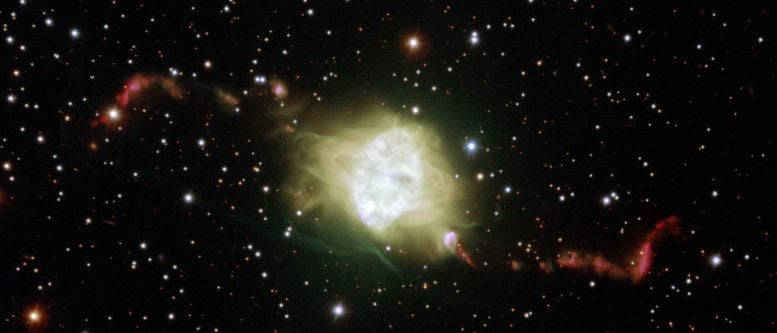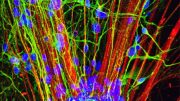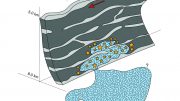
This new ESO Very Large Telescope image shows the planetary nebula Fleming 1 in the constellation of Centaurus (The Centaur). This striking object is a glowing cloud of gas around a dying star. New observations have shown that it is likely that a very rare pair of white dwarf stars lies at the heart of this object. Their orbital motions can fully explain the remarkably symmetric structures of the jets in the surrounding gas clouds in this and similar objects. Credit: ESO/H. Boffin
Using ESO’s Very Large Telescope, a team of astronomers discovered that Fleming 1 is likely to have two white dwarfs at its center, circling each other every 1.2 days.
Astronomers using ESO’s Very Large Telescope have discovered a pair of stars orbiting each other at the center of one of the most remarkable examples of a planetary nebula. The new result confirms a long-debated theory about what controls the spectacular and symmetric appearance of the material flung out into space. The results are published in the 9 November 2012 issue of the journal Science.
Planetary nebulae are glowing shells of gas around white dwarfs — Sun-like stars in the final stages of their lives. Fleming 1 is a beautiful example that has strikingly symmetric jets that weave into knotty, curved patterns. It is located in the southern constellation of Centaurus (The Centaur) and was discovered just over a century ago by Williamina Fleming, a former maid who was hired by Harvard College Observatory after showing an aptitude for astronomy.
Astronomers have long debated how these symmetric jets could be created, but no consensus has been reached. Now, a research team led by Henri Boffin (ESO, Chile) has combined new Very Large Telescope (VLT) observations of Fleming 1 with existing computer modeling to explain in detail for the first time how these bizarre shapes came about.
This animation shows how the two stars at the heart of a planetary nebula like Fleming 1 can control the creation of the spectacular jets of material ejected from the object.
The team used ESO’s VLT to study the light coming from the central star. They found that Fleming 1 is likely to have not one but two white dwarfs at its center, circling each other every 1.2 days. Although binary stars have been found at the hearts of planetary nebulae before, systems with two white dwarfs orbiting each other are very rare.
“The origin of the beautiful and intricate shapes of Fleming 1 and similar objects has been controversial for many decades,” says Henri Boffin. “Astronomers have suggested a binary star before, but it was always thought that in this case the pair would be well separated, with an orbital period of tens of years or longer. Thanks to our models and observations, which let us examine this unusual system in great detail and peer right into the heart of the nebula, we found the pair to be several thousand times closer.”
This pan video shows a close-up of a new ESO Very Large Telescope image of the planetary nebula Fleming 1 in the constellation of Centaurus (The Centaur). This striking object is a glowing cloud of gas around a dying star. New observations have shown that it is likely that a very rare pair of white dwarf stars lies at the heart of this object, a fact that can fully explain the remarkably symmetric structures of the jets in the surrounding gas clouds.
When a star with a mass up to eight times that of the Sun approaches the end of its life, it blows off its outer shells and begins to lose mass. This allows the hot, inner core of the star to radiate strongly, causing this outward-moving cocoon of gas to glow brightly as a planetary nebula.
While stars are spherical, many of these planetary nebulae are strikingly complex, with knots, filaments, and intense jets of material forming intricate patterns. Some of the most spectacular nebulae — including Fleming 1 — present point-symmetric structures. For this planetary nebula it means that the material appears to shoot from both poles of the central region in S-shaped flows. This new study shows that these patterns for Fleming 1 are the result of the close interaction between a pair of stars — the surprising swansong of a stellar couple.
“This is the most comprehensive case yet of a binary central star for which simulations have correctly predicted how it shaped the surrounding nebula — and in a truly spectacular fashion,” explains co-author Brent Miszalski, from SAAO and SALT (South Africa).
This video starts with a wide-field view of the spectacular southern part of the Milky Way. We close in gradually on a small bubble of glowing gas in the constellation of Centaurus (The Centaur). This is the planetary nebula Fleming 1, glowing gas shells and symmetrical jets around an aging pair of stars. The final detailed view comes from the FORS2 instrument on the Very Large Telescope at ESO’s Paranal Observatory in Chile.
The pair of stars in the middle of this nebula is vital to explain its observed structure. As the stars aged, they expanded, and for part of this time, one acted as a stellar vampire, sucking material from its companion. This material then flowed in towards the vampire, encircling it with a disc known as an accretion disc. As the two stars orbited one another, they both interacted with this disc and caused it to behave like a wobbling spinning top — a type of motion called precession. This movement affects the behavior of any material that has been pushed outwards from the poles of the system, such as outflowing jets. This study now confirms that precessing accretion discs within binary systems cause the stunningly symmetric patterns around planetary nebulae like Fleming 1.
The deep images from the VLT have also led to the discovery of a knotted ring of material within the inner nebula. Such a ring of material is also known to exist in other families of binary systems, and appears to be a telltale signature of the presence of a stellar couple.
“Our results bring further confirmation of the role played by interaction between pairs of stars to shape, and perhaps even form, planetary nebulae,” concludes Boffin.
Reference: “An Interacting Binary System Powers Precessing Outflows of an Evolved Star” by Henri M. J. Boffin, Brent Miszalski, Thomas Rauch, David Jones, Romano L. M. Corradi, Ralf Napiwotzki, Avril C. Day-Jones and Joachim Köppen, 9 November 2012, Science.
DOI: 10.1126/science.1225386









Be the first to comment on "Planetary Nebula Fleming 1 Likely Has Two White Dwarfs Circling Each Other at Its Center"